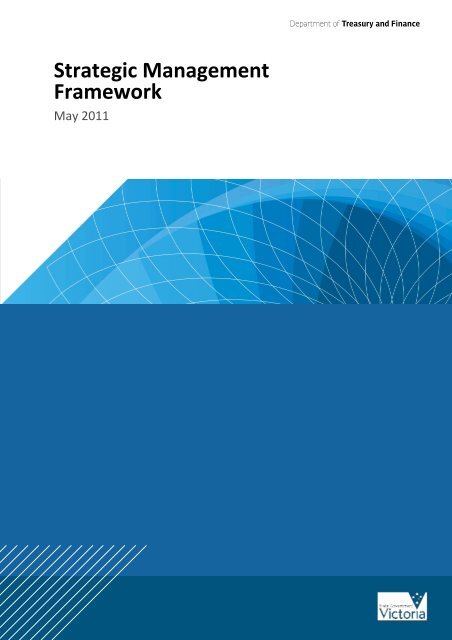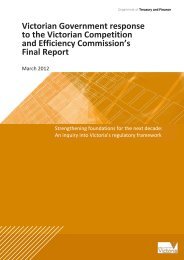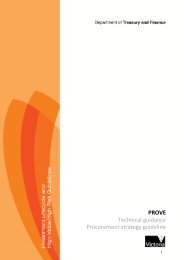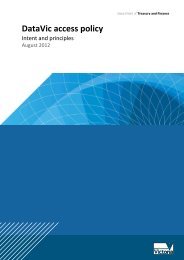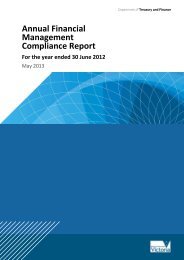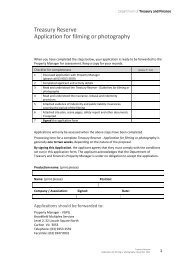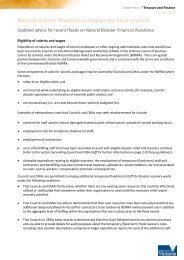Strategic Management Framework guide - Department of Treasury ...
Strategic Management Framework guide - Department of Treasury ...
Strategic Management Framework guide - Department of Treasury ...
You also want an ePaper? Increase the reach of your titles
YUMPU automatically turns print PDFs into web optimized ePapers that Google loves.
<strong>Strategic</strong> <strong>Management</strong><strong>Framework</strong>May 2011
ii<strong>Strategic</strong> <strong>Management</strong> <strong>Framework</strong>May 2011
The <strong>Strategic</strong> <strong>Management</strong> <strong>Framework</strong>The <strong>Strategic</strong> <strong>Management</strong> <strong>Framework</strong> (SMF) has been developed as a <strong>guide</strong> for theVictorian Public Sector outlining the key elements <strong>of</strong> a better practice management cycle. Itdraws upon some stages <strong>of</strong> the earlier approach to business management, the Integrated<strong>Management</strong> Cycle (IMC). However, a key difference between the two frameworks is thatthe SMF can be applied to any entity, regardless <strong>of</strong> its size.The framework is structured around six coreelements: Analyse, Plan, Allocate Resources,Implement and monitor, Evaluate andReport. Many <strong>of</strong> the elements are closelylinked or dependent on each other, and insome cases, may overlap. This is particularlythe case with the Report element, whichfeatures at each stage <strong>of</strong> the managementcycle. The SMF highlights the connectionsbetween the elements, where relevant andit is not envisaged that the stages willnecessarily be followed in a sequentialorder.After reading the SMF, entities should havea clear idea <strong>of</strong>:• the key activities that should be completed for each element <strong>of</strong> the management cycle;• questions that should be considered before progressing to the next element;• core products or reports that occur within each element, noting that some, like the StateBudget, incorporate information from a number <strong>of</strong> elements including planning,evaluation and resource allocation; and• examples <strong>of</strong> activities within each element which are currently occurring.<strong>Strategic</strong> <strong>Management</strong> <strong>Framework</strong>May 2011 1
AnalyseAnalyse processes gather, review and analyse existing information to draw conclusions andinform future approaches to activities. These processes can occur at anytime in the cycle butare particularly important before planning. Reflection, innovation and reform are central tothe Analyse element.Key activities• Gather information about the business environment from internal and external sourcesincluding data from past evaluations and consultation with stakeholders.• Analyse the information and identify key short, medium and long‐term trends, risks andopportunities.• Determine strategies to address the key reform areas taking into account governmentoutcomes.Key questions• What are the lessons learnt from past evaluations and from comparisons with othersimilar projects or organisations, and how can these be addressed in future plans?• What can be learnt from interstate and overseas jurisdictions in terms <strong>of</strong> trends andbetter practice approaches?• What are the social, economic, technological and environmental changes that haveoccurred in the recent past or that are anticipated in the future and their impact on theneeds <strong>of</strong> Victorians?• What is the capacity and capability, now and in the future, to deliver services including torespond to any changes identified above?• What are other stakeholders doing to achieve the same outcome – are activitiescomplimentary or conflicting?Key products/reports• Environmental scans;• <strong>Department</strong>’s Service and Asset Strategy; and• Research papers including options for future reform.GovernmentThe Government relies on Parliamentary committee reports and debates, local informationfrom the communities that members <strong>of</strong> Parliament represent, and research and advice fromdepartments to support its analysis <strong>of</strong> what Victorians need now and into the future andhow this can be achieved. This analysis influences decision‐making on planning and resourceallocation. It also helps the Government to determine what outcomes or communityimpacts it wants to achieve and to continue to assess whether these remain relevant to thecommunity.2<strong>Strategic</strong> <strong>Management</strong> <strong>Framework</strong>May 2011
The Government holds departments and entities to account in undertaking effectiveanalysis. Government requires rigorous and forthright analysis to support sound decisionsthat will ensure Victoria is at the forefront <strong>of</strong> innovative and value for money servicedelivery, capital investment and adoption <strong>of</strong> market‐based solutions where appropriate inthe longer term.<strong>Department</strong>s and entitiesAnalysis occurs as part <strong>of</strong> departments’ and larger entities’ routine operations. Systems arein place to collect benchmark and performance data, indicators and risk information. Thisinformation is analysed regularly and findings discussed. Studies are also commissioned onstrategic issues that may impact on the achievement <strong>of</strong> goals, such as changes todemographics and technology, as well as continued analysis <strong>of</strong> the client base and keystakeholders.In this way the organisation retains an awareness <strong>of</strong> their environment including potentialchanges that will impact on its effectiveness. This allows the organisation to prepare forthese changes and to be ready in advance <strong>of</strong> when they occur. It also means theorganisation is better equipped to influence change, for instance through implementingreforms to service delivery approaches, including adoption <strong>of</strong> market‐based solutions.Effective analysis will also ensure existing partnerships are maximised and appropriatepartnerships created.Each year, departments update their Service Strategy which is designed to anticipatechanges to the environment over a 10 year timeframe and set out a plan to respond. One <strong>of</strong>the main outcomes <strong>of</strong> this exercise is a more disciplined and strategic approach to themaintenance <strong>of</strong> relevant organisational capacity (including physical assets, services, people,facilities and equipment). Service Strategies inform strategic and corporate planning andasset management plans developed under the Asset <strong>Management</strong> <strong>Framework</strong>.The need for constant scanning and analysis <strong>of</strong> the operating environment is equallyimportant for smaller entities. Given these entities have less available resources, theprocesses employed may be less formal such as completing relevant research into betterpractice approaches and leadership teams allocating time to innovation and strategicthinking.<strong>Strategic</strong> <strong>Management</strong> <strong>Framework</strong>May 2011 3
PlanPlanning processes articulate desired goals and objectives and how these will be achieved,as well as develop the criteria to assess success. These processes draw upon the outcomes<strong>of</strong> the Analyse element to ensure available data and information informs future action.Planning occurs for the short, medium and long term and includes strategic, business andindividual performance planning.Key activities:• Determine the desired goals and the services or capital investment that will best achievethese goals.• Consider how these services or capital investment will be delivered.• Confirm measures <strong>of</strong> success including key performance indicators and identify thesystems and processes necessary to effectively measure and report on performance.• Determine individual performance learning and development objectives in the context <strong>of</strong>the skills and capability necessary in the organisation to achieve the desired goals.Key questions:• What are the vision and goals <strong>of</strong> the organisation and are there clear links to theobjectives that government is seeking to achieve?• What is the output mix with the highest potential impact on government objectives,taking into account the activities <strong>of</strong> other groups?• What needs to be planned for now to ensure that medium to longer term goals areachieved?• Are sufficient systems and processes in place to monitor and report on success and hasan evaluation been factored into the plans?• How will the services or capital investment be provided to achieve the best value formoney taking into account different models <strong>of</strong> delivery, and what funding and resourcesare required? Is a market‐based solution available?Key products/reports:• Government outcome or policy statements;• State Budget;• <strong>Strategic</strong>/business/corporate plans linked to service and asset strategies; and• COAG agreements (including National Partnerships).4<strong>Strategic</strong> <strong>Management</strong> <strong>Framework</strong>May 2011
Allocate resourcesAllocate Resources involves allocating available resources (funding, equipment and labour)to achieve the goals outlined in plans. This element includes allocating new resources andreallocating existing resources. At the whole <strong>of</strong> government level, this process primarilyoccurs via the State Budget. At other levels, these processes will occur throughout the year.Key activities• Determine budget capacity and short, medium and long term financial targets.• Consider whether existing resources can be reallocated (see Evaluate element).• Allocate available resources to best meet the organisation’s goals and objectives (seePlanning element).• Identify funding for unforeseen risks or emerging needs (i.e. contingency) and forbusiness case development/feasibility studies for potential future bids.• Confirm and communicate budgets.Key questions• Where resources should be allocated to best contribute to the Government’s objectives?• What different funding options are available?• Have productivity gains been achieved over time such that resources could be freed foruse elsewhere or services increased?• Which activities are no longer relevant to achieving government objectives and whatresources will be made available if they are stopped?• Does the organisation have the capacity to deliver in light <strong>of</strong> its other activities?Key products/reports• State Budget;• Appropriation Bills;• Internal budgets; and• <strong>Strategic</strong>/Business/Corporate Plans (i.e. these plans may include references to theallocated resources).GovernmentThe Government allocates funding through the State Budget and related processes. Finiteresources are available to the government each year and central agencies support theGovernment by assessing budget capacity and developing parameters based on estimatesand economic forecasts. The Government therefore selects which proposals for funding willhave the greatest positive impact on the community within the parameters agreed to bygovernment while also considering whether those initiatives receiving ongoing fundingshould continue or if this funding should be reprioritised.6<strong>Strategic</strong> <strong>Management</strong> <strong>Framework</strong>May 2011
Parliament scrutinises the State Budget on behalf <strong>of</strong> the community before authorising thatfunds be made available. The money authorised in the Appropriation Bills is used to fund (orpurchase) outputs from departments and some entities. These outputs are delivered inorder to contribute to outcomes or objectives. For entities, the State Budget will also impacton resource allocation, through grant funding and through the processes involved inapproving fee and charges variations.<strong>Department</strong>s and entitiesAs part <strong>of</strong> the Planning element, <strong>Department</strong>s will develop funding bids for consideration bythe Government, which reflect the <strong>Department</strong>’s preferred mix <strong>of</strong> outputs. Central agenciesprovide recommendations to government on the funding proposals including theappropriateness <strong>of</strong> the performance measures, mix <strong>of</strong> services and assets, and the cost <strong>of</strong>proposals. Reprioritisation and savings options are also presented.Once the budget allocation has been confirmed, departments undertake an internal budgetallocation process. <strong>Department</strong> budgets include State funding as well as third party and ownsource revenue. In some circumstances, departments can reallocate funding during the yearand may also seek additional or new funding from government for unforseen circumstancesor new initiatives.Entities not included in the State Budget prepare budgets using the same principles. Thismay involve a process <strong>of</strong> work groups or divisions preparing bids for funding for newinitiatives or to cover cost pressures which are then considered, prioritised and approved bysenior management, with sign <strong>of</strong>f by the Chief Finance Officer.A number <strong>of</strong> frameworks support the Allocate Resources element. These include outputprice modelling which ensures that the price government pays for the delivery <strong>of</strong> the outputis appropriate for the agreed standards <strong>of</strong> quality and quantity. The <strong>Department</strong>al FundingModel (DFM) recognises that cost pressures impact on outputs (e.g. wage and salaryincreases, CPI increases) and provides options for dealing with these pressures. The BaseReview framework also ensures the price paid for outputs is appropriate taking into accountsimilar goods or services provided by others (including non‐government suppliers), thatdelivery <strong>of</strong> the output is efficient and effective and recognising any productivity gains (seeEvaluate element).The Asset <strong>Management</strong> <strong>Framework</strong> (AMF) includes <strong>guide</strong>lines on the preparation <strong>of</strong> eachdepartment’s Service and Asset Strategy, specifications on what needs to be included in theMulti‐Year Strategies and Business Case preparation <strong>guide</strong>lines. These components <strong>of</strong> theSMF help ensure that the future asset investment responds to an established service need,is appropriately planned and has been rigorously analysed.<strong>Strategic</strong> <strong>Management</strong> <strong>Framework</strong>May 2011 7
Implement and monitorThe Implement and monitor element involves the implementation <strong>of</strong> plans using allocatedresources and monitoring progress against these plans. This includes tracking and reviewingfinances, service delivery and capital projects to ensure they are meeting their targets andobjectives are being or likely to be met. This information is used in the Evaluate element toensure services continue to be effective and are being delivered as efficiently as possible,and that assets are appropriate and sustain current service delivery.Key activities• Implement approved services and capital projects.• Implement medium to long term plans for the maintenance and or enhancement <strong>of</strong> theorganisation’s capacity, including physical assets.• Monitor and manage finances including the balance sheet, phasings and forecasts.• Measure performance regularly against key performance indicators and identify andmanage risks.• Adjust activities to improve efficiency and effectiveness and to ensure objectives will bemet.Key questions• Are there clear communication channels and accountability in terms <strong>of</strong> identifying,understanding and managing risks?• How does actual performance against financial and non‐financial measures compare tothe original plan and are these measures still meaningful and relevant?• Is performance adequate, and if not, what can be done to ensure annual targets aremet?Key products/reports• Budget Update;• Output and asset performance reports;• Monthly and quarterly annual financial reports;• Gateway reviews; and• Risk registers.GovernmentThe Government requires departments to implement their plans to meet the quality, cost,timeliness and quantity that was agreed with the Government when funding was provided.Monitoring <strong>of</strong> performance occurs formally through half yearly reports on outputperformance, financial reports, and quarterly reports on the performance <strong>of</strong> theGovernment’s capital investment program (see also Reporting element). Central agenciesprepare these reports based on information from departments which is gathered as part <strong>of</strong>the Implement and monitor element.8<strong>Strategic</strong> <strong>Management</strong> <strong>Framework</strong>May 2011
Emerging risks, including changes to cashflow or economic forecasts, are also brought to theattention <strong>of</strong> the Government. This may result in a change to the budget during the year,which is reflected (subject to timing) in the Budget Update.<strong>Department</strong>s and entities<strong>Department</strong>s and entities use allocated resources to implement their plans. At one level,this will relate to delivering outputs and associated capital projects as agreed with theGovernment, including the Commonwealth Government. At another level, it also includesimplementing business plans and individual performance plans.Monitoring <strong>of</strong> financial, output, asset and people’s performance requires effective systemsand processes. These systems and processes must capture relevant information on progressagainst agreed performance measures or KPIs and also present this data in a timely anduseful manner. <strong>Department</strong>al outputs, in particular, must be delivered and accounted for interms <strong>of</strong> the achievement <strong>of</strong> performance measures and targets established in the budgetprocess and publicly released. Depending on the size <strong>of</strong> the entity, this performanceinformation may be relied on solely by senior management or required to be reported togovernment, through central agencies (see Report element).Risk management is critical to the Implement and Monitor element. This involves ensuringall risks, including financial, reputation, physical safety, and business continuity, areexplicitly and effectively managed. This involves identifying and implementing mitigationstrategies and taking corrective action where risks eventuate, including where keyperformance indicators are not met.The Financial <strong>Management</strong> Compliance <strong>Framework</strong>, managed by the <strong>Department</strong> <strong>of</strong><strong>Treasury</strong> and Finance, provides accountable <strong>of</strong>ficers with a <strong>guide</strong> to governance, system andprocess requirements that apply to their organisation as a consequence <strong>of</strong> the relevantlegislation, regulations and ministerial directions. The <strong>Framework</strong> includes a checklist <strong>of</strong>requirements, and entities must attest annually that these requirements have been met.Gateway Reviews are another mechanism used by government to support effectiveimplementation <strong>of</strong> projects. This process relates to high‐risk capital projects and results indetailed information (gathered by an independent group) being provided to departments onperformance and risks at set stages <strong>of</strong> a project.<strong>Strategic</strong> <strong>Management</strong> <strong>Framework</strong>May 2011 9
EvaluateEvaluate processes objectively review and evaluate the success <strong>of</strong> the policy, program orproject in achieving the stated goals, including their impact on achieving outcomes, andrecommend appropriate actions. To a large extent, the evaluation will use the successmeasures that are established during the Planning element.Key activities• Complete an evaluation <strong>of</strong> performance against measures or in depth evaluation <strong>of</strong>efficiency and effectiveness.• Identify recommendations for future action.• Communicate the evaluation findings and agreed recommendations.• Store relevant lessons learnt for the purposes <strong>of</strong> Analysis and Planning.• Implement changes in order to improve performance for the future.Key questions• What is the most appropriate method or form <strong>of</strong> evaluation?• Does the evaluation include information from key stakeholders?• Was the activity a success and was it delivered as intended?• What are the key lessons for the future?• Are the organisation’s activities having an impact on the achievement <strong>of</strong> stated goals andobjectives?• Are the activities the right mix to achieve the greatest impact?Key products/reports• Base Review reports;• Internal department or entity evaluations;• Performance and financial audit reports;• Annual reports for <strong>Department</strong>s and entities;• Mid Year Financial Report and Annual Financial Report; and• State Budget and Budget Update.GovernmentThe Government is accountable to the public for the achievement <strong>of</strong> outcomes for thecommunity. It must therefore ensure that the outputs being delivered on its behalf bydepartments and entities are contributing to these outcomes. To evaluate this, theGovernment relies on in‐depth reviews <strong>of</strong> outputs to understand whether they are efficient,effective and appropriately priced. These reviews are called Base Reviews and are eitherroutine reviews or are requested specifically by government. The reviews are conducted bycentral agencies, with the <strong>Department</strong> <strong>of</strong> <strong>Treasury</strong> and Finance (DTF) typically taking aleading role.10<strong>Strategic</strong> <strong>Management</strong> <strong>Framework</strong>May 2011
Parliament has a role in undertaking its own evaluation <strong>of</strong> the Government’s efforts toprogress outcomes through conducting Public Accounts and Estimates Committee (PAEC)hearings, debates and question time. The Victorian Auditor‐General’s Office (VAGO) alsoconducts financial statement and performance audits <strong>of</strong> the Victorian public sector. PAECcan advise the Auditor‐General on audit priorities for the year. The reports <strong>of</strong> theAuditor‐General are tabled in Parliament.<strong>Department</strong>s and entities<strong>Department</strong>s and entities conduct their own internal evaluation programs. These may relateto projects, programs and people and include assessments <strong>of</strong> risk, efficiency, effectiveness,and appropriateness. At an operational level, routine evaluation is also undertaken <strong>of</strong> theadequacy <strong>of</strong> assets, equipment, facilities, financial and human resources available to eachoutput, program or activity. In some organisations, evaluations are supported by acommunity <strong>of</strong> interest or work group, which also conduct research on trends in evaluationand new methods available.The availability <strong>of</strong> data is crucial to a successful evaluation. Ensuring that the evaluation isplanned for and that systems and processes are in place to collect relevant data (seePlanning element) will have a positive impact on the quality <strong>of</strong> the evaluation product andthe reliability <strong>of</strong> the findings. Some organisations will use consultants or people fromdifferent areas <strong>of</strong> an organisation to complete the evaluation as a means <strong>of</strong> ensuring thefindings are considered objective.The information from internal evaluations may be used to feed into other reviews or besolely for internal purposes. For example, data collected by departments may be requestedas part <strong>of</strong> Base Reviews, Auditor‐General reviews or reviews conducted by the State ServicesAuthority. <strong>Department</strong>al evaluations may also be used to support requests for furtherfunding by government <strong>of</strong> lapsing or sunsetting initiatives. <strong>Department</strong>s and entities mustparticipate fully in external reviews.The findings <strong>of</strong> the evaluation must also be communicated effectively. This includes advisingstakeholders <strong>of</strong> the outcome which can also assist in driving the organisation’s commitmentto implementing change. Findings are taken into account in the Analysis element andreflected in new or updated plans.<strong>Strategic</strong> <strong>Management</strong> <strong>Framework</strong>May 2011 11
ReportReport processes provide relevant information to stakeholders. This may range fromreporting on decisions, the success or progress towards achieving goals and key issues orrisks. These processes occur in conjunction with the other elements <strong>of</strong> the SMF (see coreproducts/reports for each element). Reporting processes support transparency andaccountability <strong>of</strong> government. Good reporting involves information that is targeted, clear,concise and understandable.Key activities• Gathering <strong>of</strong> relevant data by set timeframes.• Quality assurance to ensure that data is accurate, comprehensive and comparable.• Reporting on performance including an analysis <strong>of</strong> key trends and issues.Key questions• Is the information clear, accessible, timely and in a form that can be easily understood?• Are assumptions clearly outlined and any gaps in data or variances explained?• Are conclusions supported by facts/evidence?• Is the report available to all relevant stakeholders?• Are systems in place to manage data security and integrity risks?• Are there opportunities to reduce duplication <strong>of</strong> reporting processes?GovernmentThe Government reports to Parliament on its performance, and financial targets. Thisincludes the State Budget, Budget Update, Quarterly Financial Report, Mid‐Year FinancialReport, Annual Financial Report and individual annual reports <strong>of</strong> departments and entities.This allows public scrutiny and feedback on government’s performance. Based on thisinformation, and other information from the community, Parliament is able to make (usuallynon‐binding) recommendations to government, to commission further reviews byparliamentary committees or recommend specific audits by VAGO.Government also relies on reports from central agencies on performance and emergingrisks. Central agencies collect and consolidate information from departments and entities onperformance, <strong>of</strong>ten as part <strong>of</strong> the Implement and Monitor element. Once this is complete,central agencies prepare reports to government using this information and include analysisand recommendations as to how performance could be improved or risks better managed.These reports include output and asset investment reports which are internal togovernment.Government, through departments and entities, also reports to defined sections <strong>of</strong> thecommunity with information specific to their interests – for example, Melbourne Waterreports daily status <strong>of</strong> water storage levels to the community and the <strong>Department</strong> <strong>of</strong> Healthreports hospital access statistics in a quarterly public report.12<strong>Strategic</strong> <strong>Management</strong> <strong>Framework</strong>May 2011
<strong>Department</strong>s and entitiesGuidance is provided to departments and entities on the format, content and timing <strong>of</strong> anyinformation used in reports to government on performance. <strong>Department</strong>al secretaries (andtheir senior management team) are responsible for ensuring that the department or entitymeets its reporting obligations.The <strong>Department</strong> <strong>of</strong> <strong>Treasury</strong> and Finance (DTF) is principally accountable for thecompleteness and accuracy <strong>of</strong> published financial reports, and for ensuring that they areeasy to read and interpret, faithfully represent the position, and are produced on time. Itdischarges this responsibility in partnership with departments and entities.<strong>Department</strong>s and entities will regularly report to their relevant minister, whether throughformal reports or written or verbal briefings. Internal reporting will also occur throughoutthe organisation and will be driven by the specific needs and size <strong>of</strong> that organisation withlarger entities requiring more formal and systematised collation and reportingarrangements.<strong>Strategic</strong> <strong>Management</strong> <strong>Framework</strong>May 2011 13
www.dtf.vic.gov.au14<strong>Strategic</strong> <strong>Management</strong> <strong>Framework</strong>May 2011


